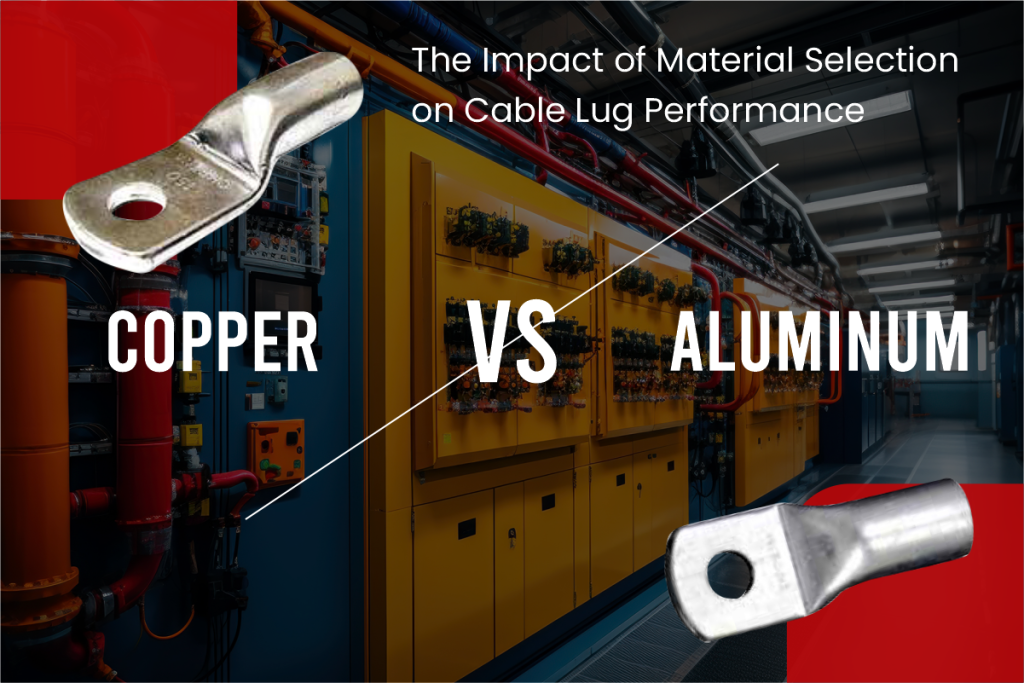Selecting a terminal lug is a critical decision – when it comes to electrical engineering as well as power distribution systems, the material of the lug can affect greatly. Going for the right material can influence the safety, durability, and performance of your systems.
As crucial components utilised to connect electrical devices to cables, cable lugs ensure secure and efficient transmission of electrical power. Such lugs are primarily made of one of the two materials: copper or aluminium.
Both copper and aluminium have their own set of properties, features, and advantages of utilisation. This makes the choice between them extremely impactful on the performance of your lug. In this blog, we will explore how either of these materials affects the performance and their applications.
Electrical Performance and Conductivity
It is no news that copper is an excellent conductor of electricity. Copper cable lugs also ensure efficient transfer of power with minimal electrical resistance. All of this has made copper a go-to choice as the top material for manufacturing such lugs.
Copper cable lugs are thus best for utilisation in high-power applications where energy losses are to be kept low and good performance is crucial. Such features add to the efficiency of these copper lugs. Furthermore, this exceptional conductivity can be reflected in the size of the lugs – these can be smaller in size as compared to lugs made from aluminium. This can allow for more space-saving and compact designs of the electrical systems.
Aluminium as a material does not have the same level of conductivity as copper. This means that there is a significant reduction in the level of electrical performance as compared to copper lugs. Moreover, because of this lower level of conductivity, aluminium lugs have to be larger in size to compensate, leading to heavier and bulkier installations in electrical systems.
There have been a number of advancements in technology that have tackled these shortcomings in the conductivity and design of aluminium cable lugs. Such mitigation has made aluminium a feasible choice as a material for terminal lugs.
Strength and Durability
When selecting a material for your lugs, an influential factor is its mechanical strength. Copper as a material for lugs is inherently ductile and has high tensile strength. This makes lugs made from copper greatly resistant to the mechanical stress of the electrical system.
Such sturdiness helps copper cable lugs maintain their structural integrity under a number of working conditions. Copper lugs are also much less likely to break, warp, or deform, adding to the reliability of their performance for a longer time.
As opposed to copper, aluminium does not possess the same level of mechanical strength but offers adequate durability and longevity for a number of applications. Advancements in technology have paved the way for modernised aluminium alloys which offer improved strength and durability.
Such uses of aluminium in lugs have been bridging the gap between the choice of copper and aluminium as materials for lugs. However, in order to ensure that your electrical connection is secure, sustainable, and reliable, appropriate installation practices need to be in place to avoid long-term damage.
Thermal Conductivity
In order to ensure that an electrical system is safe, heat management is crucial to ensure its overheating and secure operations. This is where the high thermal conductivity of copper cable lugs comes into the picture – it disperses heat effectively, ensuring that the risk of failure because of thermal buildup is low.
Such properties that dissipate heat are crucial and beneficial when it comes to applications that require high current and the generation of heat can be significant. This makes copper one of the top contenders for manufacturing terminal lugs.
The thermal conductivity of aluminium is comparatively less than that of copper. However, its performance in heat management is still adequate. Lugs made from aluminium are bulkier and have larger surface areas – this offsets their lower conductivity.
Irrespective of their surface area, however, the difference in their thermal conductivity becomes more prominent when the operating conditions are extreme. This is why as far as thermal conductivity is concerned, copper is generally the preferred alternative for cable lugs in applications where the thermal management requirements are stringent.
Resistance to Corrosion
To ensure the longevity and dependability of a lug, one of the most key considerations is its resistance to corrosion. As copper is inherently resistant to corrosion, it is the most suitable choice for lugs in a number of environments, even where the exposure to corrosive substances is high.
Copper cable lugs can hold their structural integrity and, in turn, their performance for extended periods of time. This can reduce the need for repeated requirements for maintenance and replacements.
Aluminium is not as resistant to corrosion as is copper. Even so, with adequate protective measures, lugs made from it can still perform satisfactorily. Lugs made from aluminium are coated with protective layers or treated with substances that enhance their resistance to corrosion. Even so, in extreme conditions, copper lugs are majorly preferred because of their superior corrosion resistance.
Final Thoughts
To sum it up, material selection is crucial as it can directly affect the performance of your cable lugs. You need to consider the electrical, thermal, as well as mechanical factors before choosing between copper and aluminium for the material of the lug.

